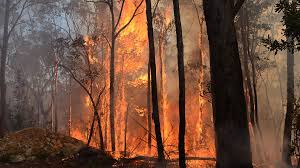In a study released today in Nature Geoscience, we show that extreme weather events in Australia such as drought and bushfire are linked to temperature changes in the Indian Ocean. Much like El Niño in the Pacific Ocean, the Indian Ocean Dipole has far-reaching consequences, and these effects are likely to strengthen under climate change.
What is the Indian Ocean Dipole?
Like El Niño, the Indian Ocean Dipole (IOD) is an interaction between the ocean and atmosphere.
The IOD appears and develops in the Southern Hemisphere winter and matures in spring. In its positive phase, which is the one that interests us most, sea temperatures off the cost of Sumatra and Java are lower than normal. Meanwhile in the western equatorial Indian Ocean, off the coast of Kenya, sea temperatures are warmer.
(The IOD also has a negative phase, but this is much rarer, and its effects much more benign.)
These seemingly small changes in sea temperature have profound effects on the atmosphere. Convection — rising warm, moist air — and rainfall tend to follow the warmest sea temperatures. So changes in sea temperature dramatically alter atmospheric circulation and rainfall distribution.
The result, in the case of the IOD, is extreme weather in many parts of the world, including severe droughts in Indonesia and devastating floods in East African countries.
For Australia, our research confirmed links between this Indian Ocean phenomenon and extreme weather events in southeast Australia, for example, bushfires such as those that occurred on Black Saturday.
During a positive IOD event, south east Australia sees decreased rainfall and increased temperatures. This is because much of the moisture supplying rainfall over south east Australia in winter and spring come from the tropical eastern Indian Ocean. Less rain and clear skies lead to higher temperatures than normal.

Cool waters over the western Indian Ocean cause drought and extreme fire conditions in Australia. CSIRO
More than a statistical fluke
In earlier studies, scientists showed that there are statistical links between the IOD and extreme weather in Australia.
In this new research we’re able to show that these linkages are not statistical flukes, and can in fact be predicted by climate models.
And because these events can be simulated by models, we can use these models to find out whether positive IOD events will become more common in a warming world.
We examined 54 climate models and experiments that participated in the International Panel on Climate Change’s Fifth Assessment Report. These model experiments include the historical period up to 2005, and a future period under a high emissions scenario. These experiments provide a large number of samples with thousands of years of virtual climate, which allows us to distill climate change signals.
How might the IOD change in the future?
Over the past 50 years, the IOD index (how we measure the difference in sea temperatures between the western and eastern Indian Ocean) has been trending upwards. Climate models suggest it will continue to do so over the next 100 years.
This predicts a drying trend over south east Australia, and more IOD events compared to the present climate.
In a warming world, the eastern Indian Ocean warms less than the west, and tropical rainfall and moisture move away from the eastern Indian Ocean, resembling a positive IOD event.
This slow warming pattern will lead to more frequent IOD events, and the associated dry conditions will be more intense, compared with the present-day climate. The bottom line is that the rain is moving away from Australia.
What does this mean for Australia?
Our major bushfires in summer have been linked with a positive IOD in winter and spring, and therefore the IOD offers a way of predicting summer bushfire conditions. This research enables us to better anticipate drought and increased bushfire risk.
This is because we have some four to six months of lead time before the fire season. An IOD in winter and spring is a warning sign of higher than normal fire risks in the upcoming summer.
In future climate, a decline in spring rainfall and a rise in temperature induced by an IOD event, exacerbated by a long-term drying trend in a warming climate, will greatly increase the risk of major bushfires.
The implications are of course far broader than Australia. The IOD has, to date, preconditioned wildfires in Indonesia, caused coral reef death across western Sumatra, and exacerbated malaria outbreaks in East Africa. We expect these extreme events to become more intense in the future.
Wenju Cai is a researcher at CSIRO. She received funding from Australian Climate Change Science Programme and the Goyder Research Institute.
![]() This article was originally published at The Conversation.
This article was originally published at The Conversation.
Read the original article.










